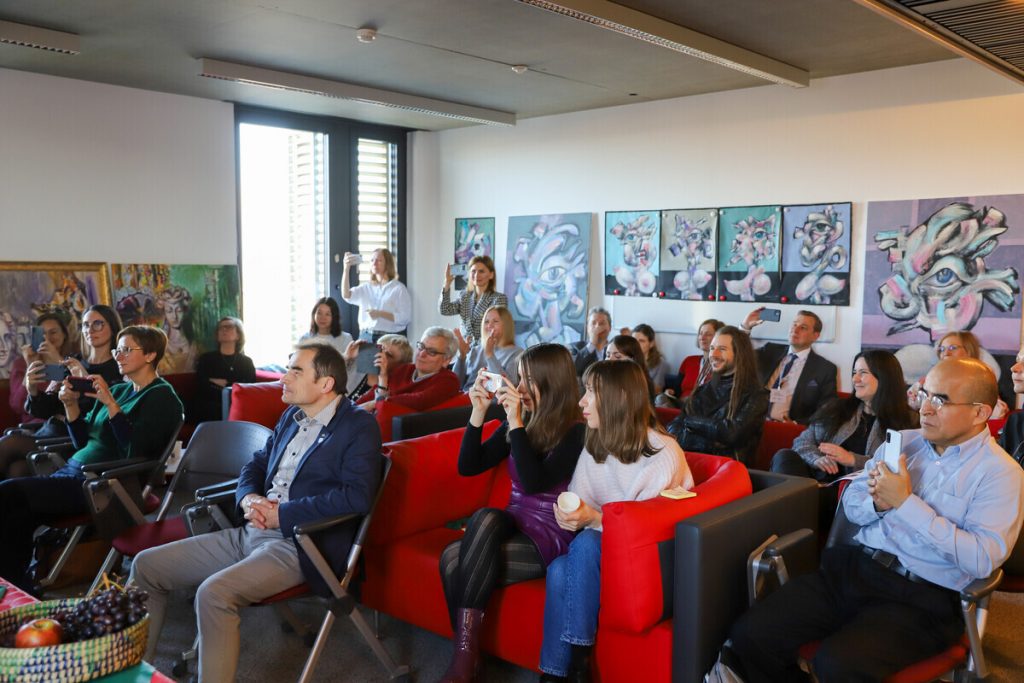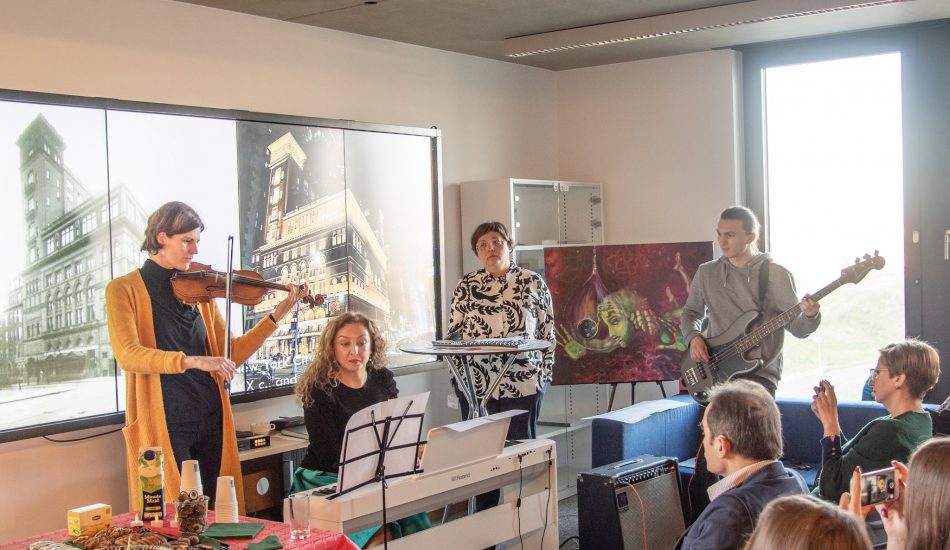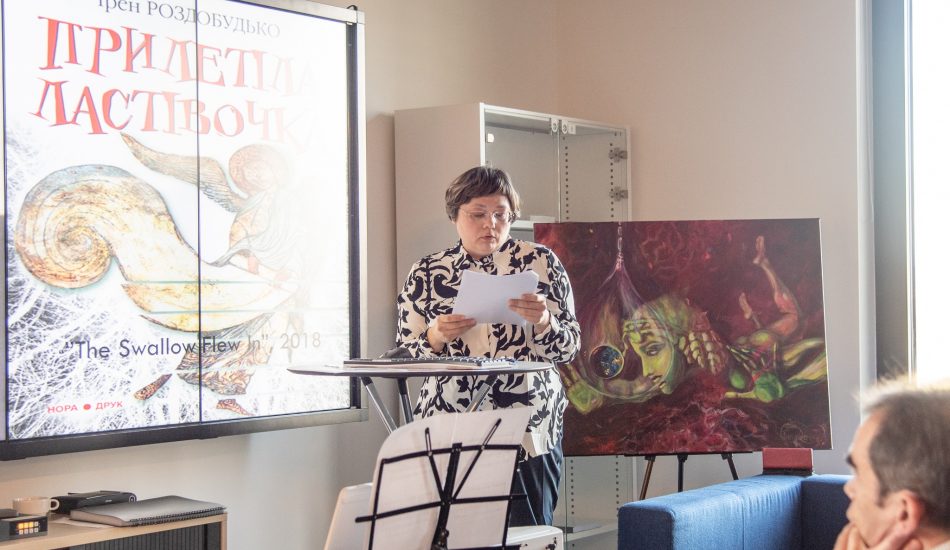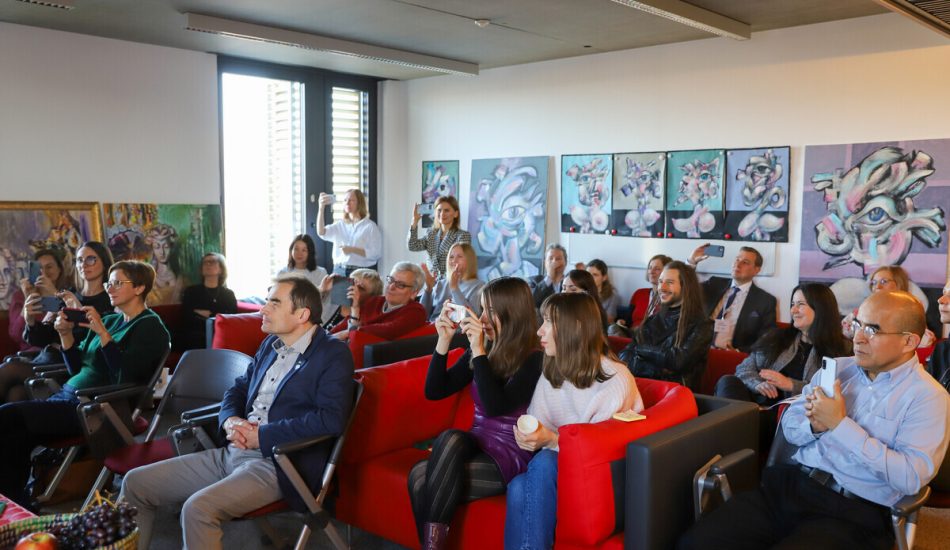
Being a visiting researcher at the University of Luxembourg, Oksana Karbashevska, Associate Professor of the Department of English Philology at Vasyl Stefanyk Precarpathian National University, gave a lecture in English on the topic “Ukrainian “Shchedryk” and American “Carol of the Bells”” before Ukrainian and foreign listeners at the meeting of “Luxembourg Ukrainian Researcher Network” LURN 3.
The paper highlighted the history of the popularity of the Ukrainian calendar-ritual song “Shchedryk” in the USA, as well as the modern musical contexts of the functioning of “Shchedryk” and “Carol of the Bells”, the intercultural exchange of melodies due to modern technologies, and the subsequent tour of the Ukrainian song in European countries, in particular in Luxembourg. This incredible century-old story of “Shchedryk” visualises the importance of folklore in the modern cultural space, its role in the preservation and presentation of the Ukrainian cultural and national identity.
The lecture on the theme “Ukrainian “Shchedryk” and American “Carol of the Bells”” allowed to reveal the following questions:
On January, 24, 1919, the Ukrainian People’s Republic (1917-1920), that made attempts to gain independence for Ukraine, issued the Act on creating the Ukrainian Republic Capella. Its task was to travel abroad with the Ukrainian repertoire and promote Ukrainian culture.
In the capital of Ukraine, Kyiv, Oleksandr Koshyts (1875 – 1944), a Ukrainian choral conductor, and Kyrylo Stetsenko (1882 – 1922), a Ukrainian composer, held auditions and recruited 100 choristers. However, already before February, 5, 1919, due to the second invasion of Kyiv by the bolshevik Red Army, part of the Capella got evacuated from Kyiv and arrived in the city of Kamianets-Podilskyi, now the western part of Ukraine. The choir stayed there till the end of March having two rehearsals and a French class every day.
The European tour of the Ukrainian Republic Capella
The European tour of the Ukrainian Republic Capella began with the first performance in Prague, Czechoslovakia, in May, 1919. The concerts had a triumphant success. Numerous positive and praising reviews were given in European newspapers. For the Europe of that time, polyphonic acapella singing was unusual. And music reviewers furtively went backstage to check if somebody was accompanying the choir. During performances, Oleksandr Koshyts conducted the choir without a baton, and forbade the choristers to use the music notation. During their European tour, the Ukrainian Republic Capella gave concerts in Austria, Belgium, England, France, Germany, the Netherlands, Switzerland, and other countries.
Ukrainian “Shchedryk” and Mykola Leontovych
One of the most popular songs performed by the choir was “Shchedryk”. It’s a Ukrainian folk calendar-ritual song, whose melody was arranged by the Ukrainian composer Mykola Leontovych (1877-1921). The composer worked on the arrangement of the “Shchedryk” melody for nearly 20 years. The five versions or editions of the tune cover the period from 1901 up to 1919.
Mykola Leontovych himself was sceptical about his own music. When the Ukrainian Republic Capella wanted to take some of his songs into their repertoire, and asked the composer to give them his sheet music, he refused, stating that his music was not well arranged, and didn’t deserve to be sung on the stages of Prague or Paris. The songs by Mykola Leontovych were taken by the choir without the author’s permission.
In January of 1921, the Ukrainian composer Mykola Leontovych was shot in the house of his parents in the village of Markivka, now Vinnytsa Region, Ukraine, by a member of the All-Russian Extraordinary Commission.
The American tour of the Ukrainian National Chorus,
Peter Wilhousky and his “Carol of the Bells”
The financial support of the Ukrainian Republic Capella disappeared together with the Ukrainian People’s Republic in 1921. The Capella broke up into three choirs. It was the Ukrainian National Chorus led by Oleksandr Koshyts that made its way to the United States. Their first performance took place at Carnegie Hall, New York City in 1922.
The legend has it that it was at this concert in Carnegie Hall that the American composer and conductor of Ukrainian origin Peter Wilhousky (1902-1978) heard the Ukrainian folk song called “Shchedryk”. Peter Wilhousky (1902-1978) created his own version, with new lyrics and a title – “Carol of the Bells”. He published and copyrighted it in 1936. “Carol of the Bells” has become an inseparable part of Christmastime in the US. As a matter of fact, the “Shchedryk” melody by Mykola Leontovych gave rise to four American carols. However, the best known one belongs to Peter Wilhousky.
In spite of the defeat of the Ukrainian liberation movement in the first quarter of the XX th c., and turning Ukraine into a silent and subdued part of the Soviet Union through repressions against its population, the Ukrainian calendar-ritual song “Shchedryk” in the shape of the American “Carol of the Bells” presented the Ukrainian identity and nation in the international arena, proved its worth and value, and gained its popularity.
The modern contexts of Ukrainian-American “Shchedryk”
and “Carol of the Bells”
Speaking of Ukrainian “Shchedryk”, one would expect to hear the following performance, e.g. by Hryhorii Veryovka Ukrainian National Honoured Academic Folk Choir (https://www.youtube.com/watch?v=TPhDRMr6ttM).
However, in 2015, Nataliia Mykhailenko, the conductor of the people’s amateur chamber choir “Acsios” from the town of Tlumach, Ivano-Frankivsk Region, Ukraine, got interested in the updated melody of the “Carol of the Bells” (2012) by the American band “Pentatonix”: https://www.youtube.com/watch?v=WSUFzC6_fp8.
The choir “Acsios” combined the American “Pentatonix” music and Ukrainian lyrics, creating a new Ukrainian Christmas carol. They demonstrated this innovation at the VI th Christmas Festival “Koliada na Maizliakh” (Christ the King Church, Ivano-Frankivsk, Ukraine, 2015). The “Acsios” choir video was kindly granted by its conductor. Thus, Ukrainian “Shchedryk” returned from the United Sates to Ukraine after its 100-year-old international concert tour.
Finally, “Shchedryk” and “Carol of the Bells” were, or it’s better to say, was performed at the concert “Notes from Ukraine” at Carnegie Hall, New York, US, in December, 2022. You can watch about it from NBC News: https://www.youtube.com/watch?v=rdR7rUsPNnA&t=106s
Furthermore, in December, 2022, Ukrainian “Shchedryk” was sung by a Luxembourg Choir. The world tour of the Ukrainian song is going on…




